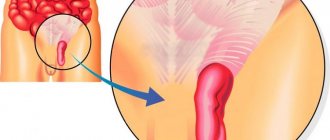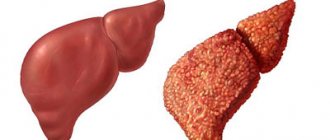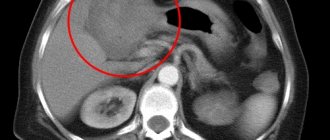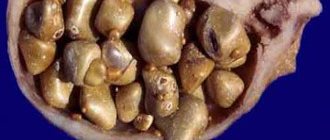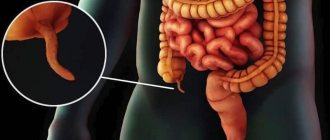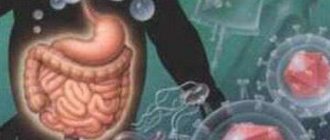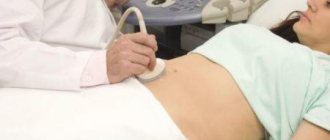The liver is one of the most vital organs, on whose “shoulders” many functions are assigned. First of all, this is detoxification (neutralization of toxins), synthesis of bile, processing of fats, formation of glucose and glycogen reserves, as well as metabolism of vitamins and a number of hormones. The specificity of liver diseases in men and women is the difficulty of diagnosis. In the early stages, it is quite difficult to determine the type of disease due to unexpressed symptoms, so people often go to the doctor when certain changes have already occurred in the body.
General symptoms
The category of liver pathologies can include any structural transformations that do not go beyond the anatomical boundaries of the organ, including hepatic lobules, intrahepatic bile ducts, non-pathocytes, and venous vessels.
In typical cases signaling problems with the liver, the clinical picture is as follows:
- frequent migraines and general malaise;
- periodic temperature rise within 37.1 – 37.3 °C;
- acquiring a icteric tint to the skin;
- the appearance of skin rashes on different parts of the body;
- discomfort in the liver area and an increase in its volume when palpated;
- excessive sweating;
- unmotivated weight loss or, conversely, an increase in abdominal size;
- proliferation of the venous network in the chest and abdomen;
- change in the structure and color of stool (from brown-black to green-yellow);
- accumulation of bitterness in the mouth and the appearance of a metallic taste;
- memory impairment and decreased mental and thinking abilities;
- coating of the tongue with a yellowish and white coating;
- continuous thirst;
- presence of signs of hypovitaminosis;
- hunger;
- blurred vision;
- insomnia;
- rapid heartbeat amid attacks of alternating cold and heat.
Liver diseases also have accompanying symptoms: hair and eyebrow loss, the formation of papillomas on the body, limb cramps, atherosclerosis of the vessels of the legs and intestines.
Learn more about the symptoms of liver problems in this video.
Nonspecific symptoms
The problem is that signs of liver inflammation in men are often absent. Diseases of the organ can develop asymptomatically for a long time and make themselves felt only at the onset of the chronic stage. This is due to the absence of nerve endings, which send signals to the brain about problems with other organs.
However, it is possible to identify some nonspecific signs that indicate a malfunction of the liver. These include:
- fatigue;
- digestive disorders;
- sleep problems;
- frequent colds;
- pale or yellow skin;
- varicose veins;
- hormonal disorders and obesity.
These signals come from different organs and systems; it is difficult to suspect a liver problem on your own. Therefore, many men miss the onset of the disease. Just don't joke with your health.
Pain
It all starts with quite tolerable pain. However, they gradually become stronger. A characteristic feature of liver diseases is the place where pain appears; in such cases, the pain is always in the upper abdomen on the right. Abdominal bloating is often associated with an increase in liver size.
Temperature
Men often perceive elevated temperature as a symptom of acute respiratory viral infection, especially with an accompanying general malaise. However, this may also be a sign of cirrhosis. In such cases, the temperature rises to 37.8-38 degrees. 39 degrees is already a clear symptom of purulent liver inflammation, especially in the presence of fever.
Weakness
When bile begins to circulate through the blood, it causes intoxication of the entire body. This is accompanied by loss of strength and headache. Against this background, men’s mood deteriorates.
Nausea
One of the vital functions of the liver is the neutralization of toxins that the body cannot cope with on its own. However, if the organ malfunctions, foods high in fat, flour, salt, and seasonings are not completely digested. Because of this, nausea occurs, which is accompanied by general malaise and weakness.
This is interesting: Signs, symptoms and treatment of liver inflammation with tablets and folk remedies
Vomit
Nausea may be accompanied by vomiting, which provides temporary relief. In case of liver pathologies, bile impurities are found in the vomit.
How can the liver hurt?
Pain syndrome manifests itself in different ways. Conventionally, they can be grouped into several forms:
- Periodic minor pain in the area of the right hypochondrium, characterized by aching pain, a feeling of heaviness and fullness. They are caused by a sluggish inflammatory process, accompanied by an increase in the size of the liver. Usually a person finds it difficult to determine a clear localization of pain.
- Intense, pronounced pain in the right hypochondrium, which is constant and progressively worsening. It speaks of an acute inflammatory or purulent process, or is a consequence of an injury with rupture of the liver tissue.
- Complete absence of pain symptoms up to the stage of detection of liver cirrhosis and liver failure.
Where does a person’s liver hurt: photo
Pain sensations in various disorders of the gland can be different, for example, with weight gain and enlargement of the liver due to adipose tissue, the patient may feel a “dull” aching pain, similar to attacks of gastritis. A very unpleasant “surprise” can be a feeling of heaviness, unpleasant belching and a taste of bile in the mouth. You can find out where a person’s liver hurts by looking at the photo.
Determining the exact location of pain in a patient can cause significant difficulties, since the pain has a dissipating nature. With inflammatory processes in the area of the gallbladder and ducts, the condition may worsen, and the patient may experience severe intoxication and dry mouth. All this is a serious reason for hospitalization and possible surgical intervention.
Skin changes in liver diseases
Skin, hair, and nails react to liver problems like litmus paper, so it is important to conduct a self-examination and pay attention to any visual abnormalities in your body. They may be:
- The appearance of white spots on the nail plates of the fingers and toes that do not have clear boundaries. This sign usually signals the transition of hepatitis to the chronic stage, as well as the development of liver cirrhosis.
- Yellowish skin tone. It is often present not only on the outer skin, but also on the mucous membranes (including the whites of the eyes) and sclera. It appears better in natural light, but indoors the color signature may become blurred.
- The appearance of stretch marks (striae), most often in the abdominal area. They look like thin, loose stripes of a bluish tint. They indicate a hormonal imbalance when the liver loses its ability to neutralize excess steroid hormones.
- Skin rash. Can be expressed in different forms. The appearance of pustular lesions and boils is a consequence of immune imbalance due to liver dysfunction and its inability to synthesize immunoglobulins. Allergic rashes (dermatitis, eczema, psoriasis) are caused by loss or impairment of the detoxification function of the liver. A hemorrhagic rash indicates a decrease in the synthetic function of the liver, which affects blood clotting. As a result, a person becomes vulnerable to the formation of bruises and hematomas even with the slightest injury.
- Spider veins. They form not only on thin areas of the skin (face, neck), but also throughout the body: back, limbs, abdomen. They are considered a classic manifestation of liver cirrhosis that has entered the active phase.
- Itching. It is a stable “companion” of skin rashes and jaundice. This is explained by the fact that unprocessed toxic substances are concentrated in the upper layers of the epidermis and, accordingly, cause irritation. Unneutralized bilirubin is also deposited in the skin, which is why patients with various liver pathologies often have scratch marks on the forearms, abdomen, and thighs.
- Brown coloration of the groin area and armpits. It is a sign of the development of hemochromatosis and cirrhosis of the liver.
Secondary skin signs that signal a malfunction of the liver may include cracks (seizes) in the corners of the mouth, too bright a color of the tongue, and swollen veins on the abdominal surface.
What is needed to treat liver diseases?
Diet is one of the main methods of therapy for liver dysfunction; at the initial stage of disease development, it is enough to reconsider your diet and lifestyle in order to get rid of unpleasant sensations. Drug treatment helps to cope with discomfort in severe forms of pathologies, prolong the remission stage, and reduce the risk of complications.
Nutrition
If the liver is damaged, proper nutrition helps normalize the digestion process and the outflow of bile, helps reduce the load on the organ, and eliminate dysfunction.
The basis of the diet is proteins and carbohydrates, fats in minimal quantities. Boiled, stewed, steamed, baked dishes are allowed. Fatty, fried, smoked, spicy, spicy foods and alcoholic drinks are contraindicated.
| Can | It is forbidden |
|
|
Drink at least 1.5 liters of pure water, 100–200 ml of alkaline water without carbon, 300–500 ml of rose hip decoction per day.
Medicines
Drug therapy is based on the use of drugs from the following groups:
- Herbal preparations. Medicines based on milk thistle are widely used to restore liver function. Drugs such as Gepabene, Karsil, Silymarin, Silymar contain an extract from this plant and are used in the treatment of hepatitis, cirrhosis, cholecystitis or toxic liver damage. This group also includes the preparations LIV-52 (based on yarrow and chicory), Chofitol (based on artichoke). Among the group of dietary supplements, the drug Ovesol is especially popular.
- Essential phospholipids. Representatives of this group (Essentiale, Essentiale Forte, Essliver, Phosphogliv) help normalize metabolic processes in liver cells and accelerate its regeneration and recovery.
- Medicines of animal origin. Representatives of this group are produced on the basis of cattle liver hydrolysates, have protective properties and provide detoxification and cleansing of the liver. Popular drugs are Hepatosan and Sirepar.
- Medicines with amino acids. These are medications such as Heptral and Heptor. They exhibit powerful antioxidant and antitoxic effects, protect the liver and accelerate its recovery.
In addition to conservative therapy, therapeutic exercises are used, which consists of a set of specially designed exercises. In case of liver pathologies, they have a beneficial effect on metabolic processes, eliminate spasms of the biliary tract, strengthen the abdominal muscles and improve the functioning of the nervous, digestive and cardiovascular systems. It is better to perform such exercises under the guidance of an experienced instructor.
A good effect is achieved by using traditional medicine methods based on taking decoctions and tinctures of medicinal herbs. But before starting treatment, be sure to consult your doctor, this will help avoid unwanted complications. To treat the liver, milk thistle meal, decoctions of dandelion and artichoke roots are used, plants with choleretic and diuretic properties are used (rose hips, strawberry leaves, St. John's wort, corn silk, etc.). The natural drug Leviron duo has proven itself to be excellent.
Folk remedies
Hepatoprotector plants are used in the treatment of liver diseases with folk remedies.
- Milk thistle. The main herb for treating the liver is milk thistle, which normalizes liver function, protects against the effects of toxins, and restores liver cells. It is better to use seed powder or meal, which remains after squeezing the oil. Milk thistle seeds have a laxative effect, so it is not suitable for people with digestive disorders. People over 40 years of age are required to undergo liver treatment with milk thistle. Take once a year for 3-4 weeks 1 tsp. per day with a glass of water. After a course of such treatment, dark circles under the eyes, which arise due to insufficient liver function, disappear. Milk thistle is used in the treatment of cirrhosis, hepatitis, jaundice, and fatty liver hepatosis.
- Pumpkin. Take a pumpkin, cut off the top, remove the core and seeds. Fill the resulting container halfway with honey. Leave for a while until the juice appears. Drink this juice half a glass 3 times a day. Cut off the top, remove the seeds, fill with honey, close with a lid-top, cover the cut with dough. Keep the pumpkin in a dark place for 10 days at room temperature. On the 11th day, start treatment: take the resulting juice, 1 tbsp. l. 3 times a day 40 minutes before meals. The course of treatment is 1 month. Pumpkin juice will also help restore and cleanse the liver of toxins. Grate the pumpkin and squeeze out the juice, take 100 g of fresh juice 3 times a day 1 hour before meals. The course of liver treatment with pumpkin is 3-4 months.
- Carrots and raisins. 1 kg of seedless raisins, preferably lighter ones, and 1 kg of bright-colored carrots, put through a meat grinder. Place in a pan, add 1.5 liters of water, make a mark on the outside of the pan according to the water level. Add another 1 liter of water and boil over low heat until the mark is reached. Cool and strain. Store in the refrigerator, warm up to 37-40 degrees before use. Drink during the week as follows: 1st day. On an empty stomach, drink 1 glass of broth, lie down on a hot heating pad for 2 hours. 2nd – 7th days. Drink half a glass of the decoction in the morning on an empty stomach, no longer need to lie down and warm it, and have breakfast after 30 minutes.
- Immortelle. It is used in official and folk medicine as a liver remedy with bile-forming and bile-excreting properties. This herb is an effective remedy for treating the liver, bile ducts, and pancreas. To prepare a remedy for treating the liver you need 1 tbsp. l. pour immortelle flowers with 1 glass of boiling water, leave for 15 minutes and drink 50 ml 3 times a day. You cannot use immortelle for a month in a row or increase the dose - the plant accumulates in the body and has a toxic effect in large doses. After a week's rest, the course of treatment with immortelle is repeated. Often, when treated with immortelle, roundworms came out of the patient’s intestines - immortelle also has an anthelmintic effect. This plant increases blood pressure and is therefore not recommended for people with hypertension.
Digestive system disorders
Since the liver belongs to the list of organs of the gastrointestinal tract, the development of any pathology will certainly make itself felt by problems with digestion. A person may complain about:
- change in urine color;
- stool discoloration;
- heartburn and nausea;
- constipation/diarrhea
The patient also experiences bad breath, a feeling of heaviness in the abdomen and discomfort in the right hypochondrium. Almost always, symptoms are accompanied by an increase in waist circumference, as fluid begins to accumulate in the abdominal cavity.
How do liver diseases manifest in men?
Liver dysfunction does not appear for a long time, since specific symptoms appear when the pathological condition worsens and concomitant diseases develop.
The reason for this is the absence of nerve endings in the liver that transmit pain signals to the brain. Soreness becomes the result of involvement of other organs in the pathological process.
Symptoms of liver disease in men often go unaddressed even after their health worsens; some men are in no hurry to see a doctor for consultation and treatment. It happens that alarm bells are not associated with the liver at all.
Among the symptoms indicating problems with the operation of the filter organ, the following signs should be highlighted:
- excessive fatigue;
- indigestion;
- drowsiness or insomnia.
This also includes frequent cases of acute respiratory viral infections, a specific color of the skin - excessive pallor or jaundice. The consequence of hormonal imbalance in liver diseases is weight gain and obesity.
Gastrointestinal symptoms
The first signs of liver disease in men are problems with the digestive system. The patient begins to experience attacks of nausea and vomiting; the man may notice a connection between the symptoms and the consumption of spicy foods and fatty fried meat.
The liver simply cannot cope with its functions and does not fully process toxic substances that come with food. A similar picture is observed after drinking alcoholic drinks; general intoxication increases in the body.
Liver diseases are manifested by diarrhea, flatulence, a yellow or white coating may appear on the tongue, and a change in color to purple is not excluded. A specific symptom is the so-called liver odor from the mouth.
You can suspect a problem based on the following symptoms:
- lack of appetite;
- change in liver size;
- attacks of heartburn.
In the morning, there is a feeling of heaviness in the epigastric region, discomfort increases during the day, and an unpleasant taste in the oral cavity occurs. By palpation and even visually, the doctor will determine an increase in the abdominal cavity on the right side.
Liver signs on the skin
Liver signs and yellowing of the skin are not observed in all cases of liver damage in men.
Among the symptoms, skin itching most often appears; due to constant subcutaneous hemorrhages, the patient is diagnosed with spider veins.
Liver diseases provoke increased pigmentation:
- dark spots;
- freckles;
- moles.
The skin around the thumb and little finger on the upper and lower extremities turns red, and the man notices brown spots near the roots of the hair. The skin becomes cold and sticky to the touch, it is difficult for the patient to warm up, and the skin does not warm up even after intense physical activity.
Specific symptoms
A sign of a diseased liver in men is sexual dysfunction, due to the active production of female hormones. As a result of estrogen secretion, there is a decrease in libido, an increase in breast size, and testicular atrophy. In especially severe cases, a man faces impotence.
The patient's figure changes, fat deposits appear on the hips and abdomen, female-type hair growth occurs, and hair stops growing on the face. Some liver diseases have a detrimental effect on bone structures, a man experiences increased pain in the bones, bone deformities occur, and the frequency of fractures increases.
Blood clotting problems
Due to impaired absorption of vitamin K, the production of blood inhibitors decreases. The symptom makes itself felt by bleeding:
- nasal;
- gastric;
- hemorrhoidal.
In addition, slight bleeding is observed when brushing teeth.
Nervous system symptoms
A man’s character can change dramatically, causeless irritability and apathy appear, and he loses interest in life. Against the background of nervous disorders, addiction to drinking alcoholic beverages and smoking occurs. Bad habits only aggravate the situation and aggravate the medical history. In severe cases of pathology, sleep is disturbed, convulsions, hand tremors, and symptoms of intoxication appear.
Hormonal changes
Hormonal imbalances are specific to men, especially with alcohol abuse. It has been proven that excessive drinking of alcoholic beverages leads to excessive accumulation of estrogen in the body and, as a result, the mutation of male hormones into female ones.
The so-called feminization of male appearance occurs, which has the following characteristics:
- obesity with the appearance of cellulite on the thighs;
- enlargement of the mammary glands;
- loss of hair from the chest and face;
- pigmentation of the skin around the nipples;
- weakening of libido up to complete impotence;
- development of testicular atrophy.
Biliary liver cirrhosis affects the production of parathyroid hormone, which, in turn, may be accompanied by the following symptoms:
- deformations of flat bones;
- frequent spontaneous fractures;
- persistent pain in the bones.
Important: diabetes mellitus often develops against the background of certain liver pathologies.
Main types of skin manifestations
Liver diseases often go unnoticed, making themselves felt only when the condition of the organ significantly deteriorates. But even if there is no specific pain syndrome in the right precostal area, skin manifestations let you know about problems occurring in the body.
True
The symptoms associated with liver disease that appear on the skin are quite varied, but in all of them the cause is a malfunction of the liver.
Itchy skin
When liver function is impaired, the appearance of skin (cholestatic) itching is characteristic, which is associated with pathologies in the formation or outflow of bile. During the day, itching is less pronounced than at night, when it becomes unbearable and causes insomnia. Constant scratching of the skin due to itching leads to the appearance of wounds and cracks in the skin and the risk of secondary infection.
The cause of itching is a violation of the detoxification properties of the liver, in which decay products and toxic components are not eliminated in full. This becomes the basis for exceeding the amount of bile acids in the blood.
Symptoms of itchy skin appear:
- with cholestasis, as a result of impaired bile circulation and the presence of cholic acid residues in the blood;
- when hepatocytes are damaged due to viral hepatitis, infections or parasitic invasion;
- with a large number of toxins in the body - in alcoholics, drug addicts, with uncontrolled use of medications;
- with biliary cirrhosis, as a result of the penetration of bile acids into the blood;
- with cholelithiasis due to blockage of the bile ducts;
- for oncological lesions due to compression of the bile ducts.
It is important to know! According to statistics, modern men are more likely than women to experience pathological changes in liver tissue and skin manifestations typical of liver damage.
The explanation for this fact is quite simple - more frequent alcohol dependence. Alcohol syndrome is a heavy burden and reduces the liver's ability to remove toxins. That is why a picture of intoxication quickly forms - initially there is dry mouth in the morning, followed by itchy skin and a constant desire to itch.
Additional signs of liver disease in men that appear on the skin include scratching due to itchy skin. Unfortunately, only after the development of this unpleasant symptom do most men consult a doctor, but, as a rule, the initial mild illness already develops into an advanced form, fraught with cirrhosis.
For women, a risk group is those taking hormonal drugs, in particular contraceptives. The ability of this type of drug to worsen the patency of the biliary tract with the appearance of characteristic symptoms - burning of the skin, itching and rashes - has been clinically proven.
Jaundice
The most common skin lesion associated with liver disease is jaundice. The reason is a decrease in the patency of the bile ducts, which are responsible for the removal of pigments and bile salts into the intestines.
Causes of canal blockage:
- stone formation;
- inflammatory processes in the liver associated with viral hepatitis;
- with a small probability - typhus, tuberculosis, malaria.
Symptoms of jaundice:
- characteristic yellow color of the epidermis and sclera;
- urine darkens to brown;
- possible pain in the right hypochondrium;
- temperature increase up to 40 °C;
- nausea.
Treatment for liver disease with symptoms of jaundice on the skin is prescribed by a specialist: hepatologist, gastroenterologist.
- The use of hepatoprotectors with various active ingredients (Karsil, Berliotin, Essentiale) is effective.
- If necessary, antispasmodics (No-Shpa), enterosorbents (Enterosgel), and antihistamines (Suprastin) are prescribed.
- Good results in the treatment of jaundice are obtained by using folk remedies - herbal infusions and special choleretic mixtures.
Attention! Taking homeopathic medicines, using decoctions and tinctures must be agreed with your doctor. This is an important requirement because many medications do not mix well with each other and thus can cause irreparable harm.
Spider veins
Stellate angioma (spider hemangioma, spider vein) appears on the skin of the face and neck, involving the upper part of the chest. For children, it is typically located on the hands.
The spider vein is a small (1-2 mm) bright red papule (1-2 mm) with blood capillaries diverging radially. When pressure is applied, the stellate angioma becomes discolored and regains color with the cessation of action.
Spider hemangiomas, as skin manifestations of liver diseases, are benign in nature and tend to resolve. Treatment of stellate angioma is purely cosmetic. If single formations fit into the concept of normal, then the presence of more than 10 stars in a patient is a sign of the development of cirrhosis.
"Liver" purpura
Another skin pathology in liver diseases is minor hemorrhages on the skin. Hemorrhagic spots are localized throughout the body and mucous membranes.
With pressure, unlike other skin manifestations, the spots do not discolor. The size of “liver” purpura can range from tiny spots to large bruises (ecchymosis).
"Liver" tongue
A characteristic feature of patients with cirrhosis of the liver is a tongue that has a “varnished” surface, swelling and a recognizable bright red color – a “strawberry” tongue. As long as it is wet, there is no serious cause for concern.
But when liver dysfunction occurs, the surface of the tongue becomes dry, the color changes to dark red tones, even purple - the tongue becomes “crimson”. In this case, visiting a doctor becomes mandatory.
Liver palms
In patients with chronic hepatitis, the soles of the feet and palms acquire a specific red color - palmar erythema (“liver” palms). The redness is located in symmetrical patches, most pronounced in the thenar area (the raised area on the palm near the thumb) and
hypothenar (muscular tubercle of the little finger).
When pressure is applied, the stains lose color; when the action is interrupted, the color is quickly restored. There may be redness in the areas where the fingers flex.
Palmar erythema is typical for diffuse liver diseases - hepatitis, lipid metabolism disorders, and autoimmune disorders, especially in a sluggish form. It can also occur with thyrotoxicosis (excessive thyroid hormones) and occur during pregnancy.
Related
“Hepatic” often refers to not only epidermal defects resulting from liver dysfunction, but also other manifestations. In most cases, the cause of accompanying skin rashes is other diseases or age-related changes.
Pigmentation disorder
Most often, a violation of epidermal pigmentation is an age-related manifestation. Dark spots have nothing to do with hepatitis, and the name “liver” appeared due to the color of the spots - it is similar to the color of the liver.
The spots that form on the skin as we age have different names:
- pigmented;
- senile;
- hepatic;
- senile lentigo.
Pigmentation can take different forms:
- be flat on the surface of the skin;
- in the form of an oval slightly rising above the skin level;
- plaques from light to dark brown.
The appearance of pigment spots and new moles on the skin is not a manifestation of pathology; it is usually the result of exposure to ultraviolet radiation (from the sun, after visiting a solarium) or aging processes. Dermatological manifestations usually do not require treatment - only for medical reasons.
It is important to know! Intervention is required if there is a sudden change in the shape of a pigmented spot or the growth of a mole. A timely visit to a doctor will allow adequate measures to be taken in case of degeneration into a malignant form.
Rash
Infectious diseases are often accompanied by a rash. Skin rashes are typical for the following diseases:
- measles;
- chickenpox;
- rubella;
- Infectious mononucleosis;
- herpetic infection.
The cause of such a rash is pathogenic microorganisms - bacterial and viral infections. The rash can also be allergic in nature and be the body’s response to an irritant.
An allergic rash by its nature can be:
- food;
- medicinal;
- respiratory;
- contact
There is no treatment for the rash as such, since it is the result of internal processes. In cases where the rash is accompanied by severe itching, the doctor recommends taking sedatives.
Plaques
After 30 years, women may develop golden plaques on their facial skin – deposits of triglycerides and cholesterol. The plaque may be single or scattered. The typical location of cholesterol plaques is the upper and lower eyelids.
The reason for the appearance of this skin formation is not fully understood; when removed, after some time they often appear in the same place. The plaques do not pose a threat to life and health, but they look unsightly, which is what causes concern.
Purpura
A skin manifestation characterized by the formation of a mass of small hemorrhages on the surface of the skin. A typical location is the lower limbs. The cause of purpura is the body’s tendency to bleed; treatment in this case is symptomatic.
Purpura is divided into 4 groups, depending on the size of the hemorrhage.
| Size and shape of hemorrhage | Name of pathology |
| point | petechiae |
| in the form of stripes | vibex |
| small-spotted | ecchiosis |
| large-spotted | bruise |
There are several types:
- toxic (medicinal);
- rheumatoid;
- immune;
- hemorrhagic;
- thrombocytopenic;
- complex.
Eczema
A common skin disease (about 40% of all dermatological pathologies), characterized by inflammation of the epidermis and itching. Eczema manifests itself in paroxysmal returns, which can last for several days or several hours.
Main types of disease:
- acute weeping;
- chronic dry;
- microbial;
- seborrheic;
- children's and others.
The causes of eczema are different:
- immune disorders;
- hypo- and hypervitaminosis;
- gastrointestinal diseases;
- inflammatory processes in the gallbladder;
- depression;
- hormonal disorders;
- allergic reactions to synthetic clothing and others.
It is important to know! Therapeutic measures for eczema are prescribed after a complete diagnosis of the patient’s condition and are aimed at eliminating negative factors, stopping and suppressing pathological processes. Eczema tends to recur frequently, which causes difficult and lengthy treatment.
Nervous system response
With liver diseases, certain nervous disorders may occur, in particular:
- rapid fatigue even with minimal physical activity;
- chronic malaise, loss of strength;
- weakening of memory, inability to concentrate, difficulties in formulating one’s thoughts;
- tremor of fingers;
- state of drowsiness, mute and insomnia at night.
Important! In severe cases associated with rapidly progressing renal failure, patients experience epileptic seizures and short-term loss of consciousness.
Itching, rash
In addition to changes in the shade of the dermis, most people with liver pathologies experience various rashes. Let's consider the features of the mechanism of occurrence and types of rash:
- Allergic rash. It is like spots, papules. The occurrence of this symptom is due to disruptions in the detoxification function of the organ in question. These failures underlie allergies resulting from environmental exposure.
- Furunculosis, folliculitis, pustular elements. They arise as a result of an imbalance that occurs when the liver’s ability to synthesize immunoglobulins decreases.
- Hemorrhagic rash. Small hemorrhages (petechial rashes) occur over the entire surface of the dermis. The reason for their occurrence is a decrease in the synthetic function of the organ. Violation of this function affects the proteins that are included in the blood coagulation system. For this reason, patients with this disorder have a high tendency to develop hematomas, even with minor injuries.
If you notice some of the listed symptoms, it is recommended to visit a specialist. He will determine the cause that provoked the manifestation of such symptoms.
Intoxication of the body
Occurs against the background of viral liver diseases, in particular hepatitis. Also, the cause of toxic damage can be oncological processes and complications arising from cirrhosis. Symptoms are often diffuse in nature and are expressed by the following signs:
- muscle weakness;
- lack of appetite accompanied by weight loss;
- general depressed state;
- nausea;
- mood swings, feeling of inner “brokenness”;
- sudden changes in temperature;
- joint pain.
Often the provocateur of intoxication is prolonged use of anti-inflammatory, antihistamine, painkillers, as well as sleeping pills and antibiotics.
Features of the manifestation of pain in pathology
Pain in various pathologies of the organ we are considering is of a unique nature. They can be like this:
- Intense. This type of pain manifests itself in the area of the right hypochondrium. They appear in rare cases. Their occurrence indicates a purulent, inflammatory, traumatic process, injury to the bile ducts by stones.
- Minor pain. They usually appear in the area of the right hypochondrium, similar to aching pain, a feeling of heaviness, and fullness. Their appearance indicates the presence of a sluggish pathological process that has a toxic or other origin. Pain usually provokes an increase in the size of the organ and overstretching of the liver capsule.
- Severe pain, which has a local point character in the projection of the liver. It usually indicates pathology of the extrarenal bile ducts and gallbladder.
- Absence of any kind of pain. It is characteristic of indolent diseases of this organ, which can be detected only with the development of cirrhosis and liver failure.
Major liver diseases
The most common liver pathologies include:
- Hepatitis. It is an inflammation of liver tissue caused by a viral infection entering the body. There are 5 types of hepatitis: A, B, C, D, E. The most dangerous to health are the last two types, which can lead to irreversible changes in the liver and, as a result, death.
- Hepatosis. Disturbances in metabolic processes in liver cells lead to dystrophic changes in the organ. The causes of the development of the disease may be alcoholism, chemical poisoning, medication overdose, or consumption of inedible mushrooms.
- Cirrhosis. It is characterized by the development of irreversible processes to transform the structure of the liver tissue. Healthy cells lose their functionality and become overgrown with fibrous formations, which leads to partial or complete blocking of the liver.
- Liver failure. Under the influence of certain factors, the liver stops performing its functions, which subsequently leads to the development of serious pathologies.
- Cancer. The formation of malignant tumors in the liver tissue, which subsequently affects other internal organs.
The cause of liver dysfunction can be various autoimmune changes in the body, most often of a hereditary nature.
Liver diseases pose a serious threat to health, therefore, if you identify any alarming symptoms, you should not delay your visit to the doctor, as well as reconsider your lifestyle and adjust your diet, quit smoking and other bad habits, and, if possible, increase physical activity.
How to treat the disease
How the liver hurts, symptoms in men and treatment of any pathologies of this organ depends on the degree of its damage, the diagnosis and the presence of other diseases. When toxic hepatitis is detected in a patient, various procedures are carried out to remove harmful substances from the body. They also resort to techniques that help eliminate the symptoms of intoxication. The patient will still have to change his diet.
People who know how the liver hurts have a greater chance of recovery. Symptoms in men are quickly relieved by medication. Complex therapy of liver pathologies involves taking antibacterial, antiviral and other medications. In advanced cases, surgical intervention is often resorted to. During the operation, doctors excise the affected areas of the liver.
Representatives of the stronger sex should definitely be aware of liver pain. Symptoms in men, reviews and causes will help detect the disease at an early stage. To avoid problems with the gland, it is recommended:
- Avoid smoked, spicy and highly salted foods. They should be replaced with porridge, lean meat and vegetables.
- Stop drinking alcoholic beverages.
- Get rid of bad habits.
- Constantly undergo medical examinations.
- Do not neglect personal hygiene.
If symptoms of liver damage occur, you should immediately see a doctor. Remember that timely treatment will help prevent negative life-threatening consequences.

